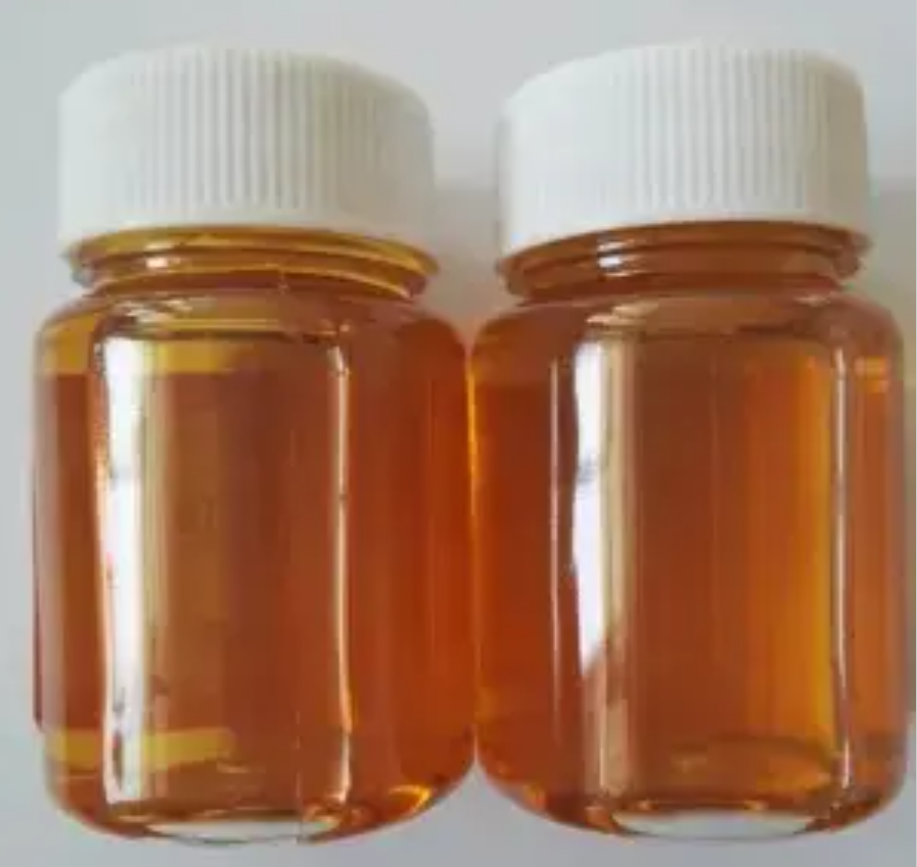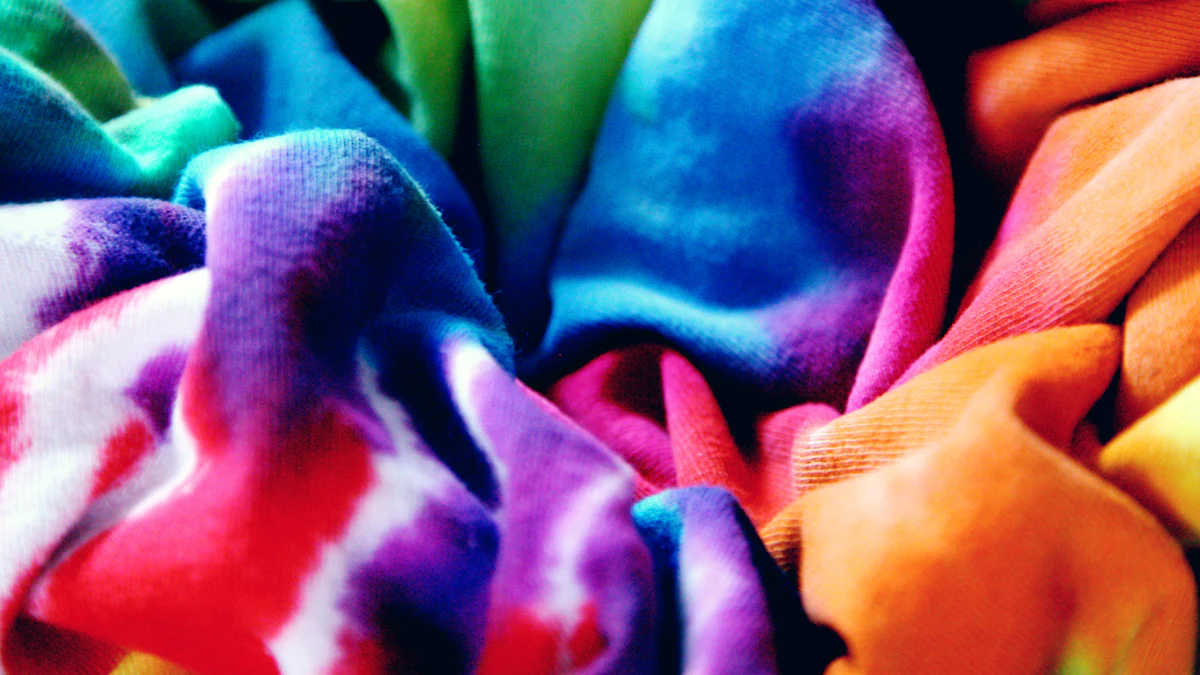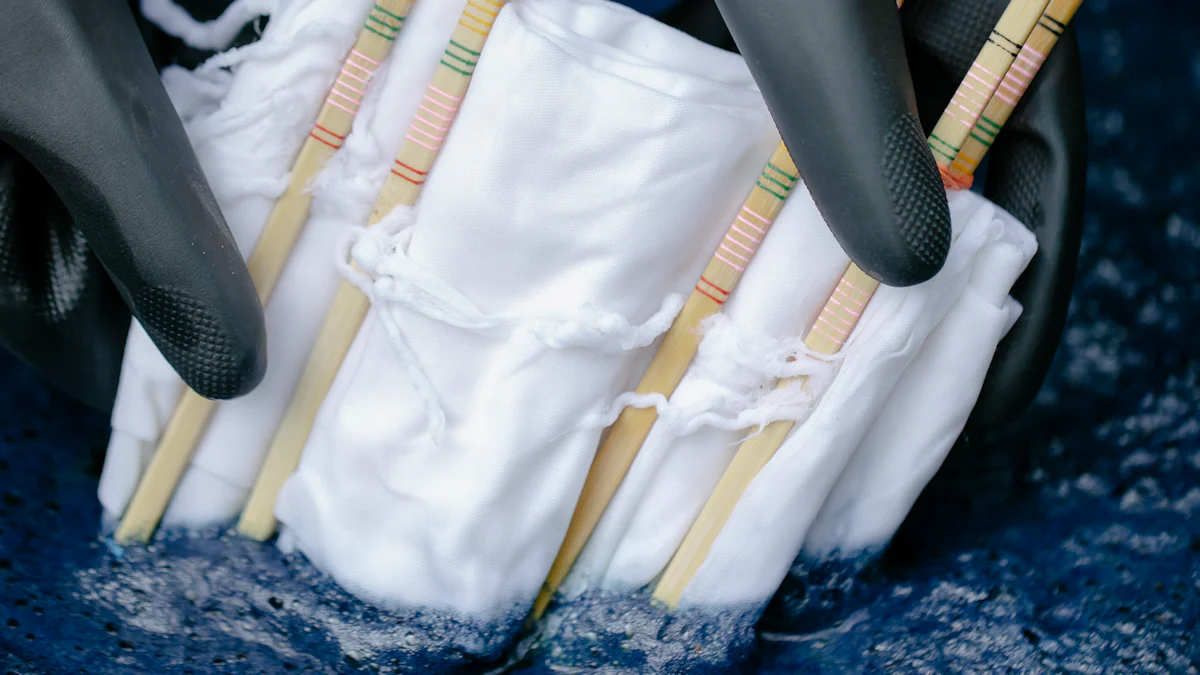 Choosing the right dyeing auxiliaries for acrylic fabrics plays a vital role in achieving high-quality results. I’ve seen how the correct auxiliaries improve colorfastness, enhance vibrancy, and maintain fabric integrity. Dyeing Auxiliaries-Acrylic Suppliers offer specialized solutions that simplify this process, ensuring consistent and reliable outcomes for acrylic materials.
Choosing the right dyeing auxiliaries for acrylic fabrics plays a vital role in achieving high-quality results. I’ve seen how the correct auxiliaries improve colorfastness, enhance vibrancy, and maintain fabric integrity. Dyeing Auxiliaries-Acrylic Suppliers offer specialized solutions that simplify this process, ensuring consistent and reliable outcomes for acrylic materials.
Key Takeaways
- Picking the right dye helpers is important for bright colors. It also helps colors last longer on acrylic fabrics.
- Clean acrylic fabrics first to get rid of dirt. This helps the dye spread evenly and avoids uneven colors.
- Talk to dye helper suppliers to find matching products. Their advice prevents errors and gives great results.
Understanding Acrylic Fabrics

Properties of Acrylic Fabrics
Acrylic fabrics have unique properties that make them stand out. These fabrics are lightweight, soft, and warm, often used as a substitute for wool. They resist wrinkles and shrinkage, making them ideal for everyday use. One fascinating feature is their ability to retain vibrant colors. Solution dyeing, a process where color pigments are added during manufacturing, enhances this property. It improves colorfastness and protects against fading, stains, and mildew.
I’ve noticed that traditional acrylic fibers were once difficult to dye. However, advancements in dyeing technology have changed this. The introduction of basic and cationic dyes has made the process more efficient. Cationic dyes, in particular, form strong bonds with acrylic fibers. This bond increases resistance to fading and ensures long-lasting colors.
Challenges in Dyeing Acrylic Fabrics
Dyeing acrylic fabrics comes with its own set of challenges. Acrylic fibers are hydrophobic, meaning they repel water. This property makes it harder for dyes to penetrate the fabric evenly. I’ve also observed that acrylic fabrics require specific dyeing conditions. High temperatures and precise pH levels are essential for successful dyeing.
Another challenge is the limited compatibility of dyes. Not all dyes work well with acrylic fibers. Basic and cationic dyes are the most effective, but even these require careful handling. Without the right auxiliaries, achieving consistent results can be tricky. These challenges highlight the importance of selecting the right dyeing auxiliaries for acrylic fabrics.
Types of Dyeing Auxiliaries for Acrylic Fabrics
Disperse Dyes for Acrylic Fabrics
Disperse dyes are a great option for synthetic fibers like acrylic. I’ve found them particularly useful when aiming for pale to medium shades. These dyes are designed to work well with hydrophobic materials, ensuring even color distribution. One of their standout features is their safety for home dyeing. This makes them a user-friendly choice for beginners. While they may not produce the deepest shades, they offer a wide range of colors that can bring acrylic fabrics to life.
Cationic Dyes and Their Benefits
Cationic dyes are my go-to for acrylic fabrics. They provide vibrant colors and excellent colorfastness. These dyes bond strongly with acrylic fibers due to the electrostatic interaction between the positively charged dye ions and the negatively charged fibers. This bond ensures high dye uptake rates and fade resistance. I’ve noticed that the dyeing process with cationic dyes involves dissolving the dye in a bath with acetic acid and other compounds. Maintaining the right temperature and pH (around 4.5) is crucial for even dyeing. Historically, dyeing acrylic fabrics was challenging, but cationic dyes have revolutionized the process.
Other Essential Auxiliaries for Acrylic Fabrics
In addition to dyes, other auxiliaries play a key role in achieving the best results. Leveling agents like Dymalev 1227 help distribute the dye evenly. Cationic retarders, such as quaternary ammonium compounds, slow down the dyeing process to prevent unevenness. Here’s a quick look at some common auxiliaries:
| Type of Auxiliary | Example |
|---|---|
| Leveling Agent | Dymalev 1227 |
| New Type Leveling Agent | Dymalev AN |
| Cationic Retarders | Quaternary ammonium compounds |
I also recommend using carrier agents, anti-pilling agents, and antifoaming agents to enhance the dyeing process. These products, often provided by Dyeing Auxiliaries-Acrylic Suppliers, ensure consistent and high-quality results.
Factors to Consider When Choosing Dyeing Auxiliaries
Compatibility with Acrylic Fibers
I always start by checking if the dyeing auxiliaries are compatible with acrylic fibers. Acrylic fabrics have unique properties that require specific auxiliaries to achieve the best results. For example, cationic dyes work well because they bond strongly with the fibers. However, not all auxiliaries are suitable. Using incompatible products can lead to uneven dyeing or damage to the fabric. I recommend consulting with Dyeing Auxiliaries-Acrylic Suppliers to find products designed specifically for acrylic materials. Their expertise ensures you get auxiliaries that enhance the dyeing process without compromising fabric quality.
Safety and Environmental Impact
Safety and environmental impact are critical factors I consider when selecting dyeing auxiliaries. Many traditional dyeing processes release harmful chemicals into water systems. Studies show that about 10-15% of dyes used in the textile industry end up in water, causing pollution. This pollution increases oxygen demand in water, disrupts algae growth, and harms aquatic ecosystems. I always look for eco-friendly auxiliaries that minimize these effects. Products labeled as biodegradable or low-impact are better choices. They reduce environmental harm and create safer working conditions for everyone involved.
Desired Colorfastness and Durability
Colorfastness and durability are essential for long-lasting results. I focus on auxiliaries that improve these qualities. For instance, leveling agents ensure even dye distribution, while cationic retarders prevent over-dyeing. These products help maintain vibrant colors even after multiple washes. I also pay attention to the fabric’s end use. For items exposed to sunlight or frequent washing, I choose auxiliaries that enhance UV resistance and wash fastness. This approach ensures the dyed fabric remains vibrant and durable over time.
Step-by-Step Guide to Using Dyeing Auxiliaries

Preparing Acrylic Fabrics for Dyeing
Preparing acrylic fabrics properly ensures the dye adheres evenly and produces vibrant results. I follow these steps to get the fabric ready:
- Rot steeping: I soak the fabric in warm water (40-60°C) overnight. This step removes starch and water-soluble impurities.
- Oxidative steeping: Next, I use an oxidizing agent like Sodium Hypochlorite or Hydrogen Peroxide. This process hydrolyzes starch and other impurities.
- Acid steeping: I treat the fabric with Sulfuric Acid to lower its molecular weight and eliminate remaining impurities.
- Enzymatic desizing: Finally, I apply an enzyme solution to remove any sizing agents left on the fabric.
These steps ensure the fabric is clean and ready to absorb dye effectively. Skipping any of these can lead to uneven dyeing or poor colorfastness.
Selecting and Measuring Auxiliaries
Accurate measurement of dyeing auxiliaries is critical. I always use precise tools like digital scales or measuring cylinders. Incorrect amounts can cause issues such as uneven colors, fabric damage, or even dimensional changes. For example, too much leveling agent might prevent the dye from bonding properly, while too little could result in patchy colors.
I also consider the type of auxiliary needed for the desired outcome. For vibrant and durable colors, I select cationic dyes and pair them with leveling agents like Dymalev 1227. When working with delicate fabrics, I opt for anti-pilling agents to maintain the fabric’s quality.
Applying Auxiliaries During the Dyeing Process
The application of auxiliaries during dyeing requires careful attention to detail. Here’s the process I follow:
- I start by adding the dye solution and gradually increase the temperature by 2°C per minute.
- Once the temperature reaches 70°C, I introduce an exhausting agent like Sodium Chloride (30-50 gpl) to transfer the dye to the fabric.
- After maintaining this temperature for 60 minutes, I add Sodium Carbonate (10-20 gpl) to fix the dye. This step takes 30-60 minutes, depending on the shade.
- I then perform a hot wash at 50°C for 15 minutes, followed by a cold wash to remove excess dye.
- To neutralize the fabric, I use 1% Acetic Acid for 15 minutes.
- Finally, I conduct hot soaping with 5 gpl soap and 1 gpl soda ash at 50°C, followed by a cold wash.
These steps ensure the dye bonds well with the fabric, resulting in vibrant and long-lasting colors. I also use a surfactant during soaping to improve rubbing fastness and develop true shades.
Common Mistakes to Avoid
Using Unsuitable Auxiliaries
Choosing the wrong auxiliaries can ruin the dyeing process. I’ve seen how using products not designed for acrylic fabrics leads to uneven colors or weak bonds between the dye and fibers. For instance, using auxiliaries meant for cotton or wool won’t work effectively on acrylic. These mistakes waste time and resources. I always recommend checking the product label or consulting with experts before selecting auxiliaries. Products from trusted Dyeing Auxiliaries-Acrylic Suppliers are specifically formulated for acrylic fabrics. This ensures better results and avoids unnecessary complications.
Tip: Always test a small fabric sample with the chosen auxiliaries before starting the full dyeing process.
Ignoring Safety Guidelines
Ignoring safety measures can cause serious problems. I’ve learned that handling chemicals without proper precautions can harm both the user and the environment. For example, failing to wear gloves or goggles might lead to skin irritation or eye injuries. Additionally, improper disposal of dyeing chemicals can pollute water sources. I always follow safety instructions provided by the manufacturer. Using protective gear and working in a well-ventilated area are essential steps to ensure safety.
Note: Keep a first-aid kit nearby when working with chemicals.
Skipping Fabric Pre-Treatment
Skipping pre-treatment often results in poor dye absorption. I’ve noticed that untreated fabrics may have impurities like oils or starch that block the dye from bonding properly. This leads to patchy or faded colors. Pre-treatment removes these impurities and prepares the fabric for even dyeing. I always make sure to follow the necessary steps, such as soaking and cleaning the fabric, before starting the dyeing process.
Reminder: Pre-treatment is the foundation of successful dyeing. Don’t skip it!
Understanding acrylic fabrics and selecting the right dyeing auxiliaries are essential for achieving vibrant, durable results. I’ve found that working with trusted Dyeing Auxiliaries-Acrylic Suppliers simplifies this process. Their high-quality products ensure consistent outcomes. Experimenting safely and following best practices will help you create stunning, long-lasting colors with confidence.
FAQ
What are dyeing auxiliaries, and why are they important for acrylic fabrics?
Dyeing auxiliaries are chemicals that improve the dyeing process. They ensure even color distribution, enhance colorfastness, and protect fabric quality during and after dyeing.
Can I use the same auxiliaries for cotton and acrylic fabrics?
No, cotton and acrylic fabrics require different auxiliaries. Acrylic fabrics need specialized products like cationic dyes and leveling agents for optimal results.
How do I store dyeing auxiliaries safely?
Store dyeing auxiliaries in a cool, dry place. Keep them in sealed containers, away from direct sunlight. Always follow the manufacturer’s storage guidelines for safety.
Post time: Jan-17-2025

